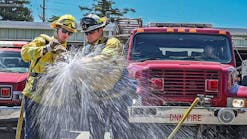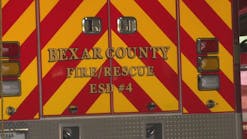Aug. 19--Her daughter lives in the house on Lagonda Avenue that Anita Martin grew up in, and Martin still returns to the old neighborhood to get her hair done.
But the Aug. 8 fire at the Tri-State Pallet Co. took Martin back further -- 62 years back to the warmish Saturday night in February when she stood as a 6-year-old in a crowd estimated to have been 1,000 and watched another fire at the same location.
On Feb. 11, 1951, the 845 Sherman Ave. building was a warehouse for Robbins and Myers Inc., a company whose presence dominated the neighborhood.
The 1345 Lagonda Ave. building that now houses Job & Family Services of Clark County was then the main office for the company everyone called R&M.
"It was a hell of an outfit," said Eldon Freeman, who had been on the Springfield Fire Division two years the night the fire broke out.
The company's shops two, three and four sat between Lagonda Avenue and tracks behind the offices, and a fair number of neighborhood residents had jobs there.
"My mother and all five of her sisters worked at R&M," Martin said.
When she went in once to apply for a job, personnel director Carl Fitzwater told her: "We're supporting your whole family," she added.
"He didn't give me the job," Martin said.
Although bolstered with reports from a former Ohio State University professor and then Wittenberg College chemistry professor John W. Barker, the official report of the fire was short on specifics.
Issued weeks later, it concluded that a build-up of natural gas from an undetermined source was set off when a member of R&M's Grasshopper Club lit a match or tossed a cigarette into the wrong place.
However sketchy, it seems to have been accurate.
"We were playing cards when suddenly there was a terrific blast, then darkness," club member George Livingston of Mechanicsburg told one of at least three Springfield News-Sun reporters covering the story.
"The blast hit me in the back like a sledge hammer."
"I was knocked down by something that hit me on the head," Marvin C. Tefft, 814 E. Rose St., told another reporter.
"I grabbed a nearby fire extinguisher, but it did no good. The entire place was in flames."
Across the street, Mrs. Harry Willis, whose home would become something of an aid station, said she "thought a bomb had fallen."
The venetian blinds shook, a window broke, and the shock waves lifted a cast iron lid off a stove, sending smoke into the house it had been warming against the February weather.
When Mrs. Willis stepped into her front yard, she heard the yells of the injured, telling the News-Sun, "they were crying like babies."
The paper's Bruce Ambrose reported that "spectators, notified of the blast by a wildfire word-of-mouth wave, flocked to the site on Sherman Avenue. Estimates ran as high as 1,000 people.
"Police had difficulty handling the crowd, which surged forward relentlessly into the street where engines and ambulances fought for space."
Martin recalled that most of the ambulances of those days belonged to funeral homes, not the fire department.
Ambrose also gave readers a scene-setting detail: "Saturday night's above freezing temperatures, coupled with broken water lines in the warehouse and firemen's spray made a muddy, snowy, slippery footing about the scene. Several of the onlookers suffered bruises ... from falls because of the greasy under-footing."
Lead reporter Robert E. Teach provided a thorough account of the facts.
"The explosion pushed a 60-foot section of wall into the street, dropping the roof into the clubroom."
"Seven of Springfield's Fire Division companies were called to the scene of the two-alarm emergency. Debris was scattered across Sherman Avenue .... (and) removal of victims was difficult because of the collapsed roof and lack of light."
Retired firefighter Freeman said the blast "knocked that sprinkler system out" and likely the alarm box to the fire department with it.
Because the alarm came in from a residential call box on Lagonda Avenue instead of the warehouse, he said, a slightly smaller crew was dispatched in the first response to the fire.
With so many units eventually sent to the fire, Freeman's, which had the only other ladder truck available, was moved downtown in case another fire broke out in the city.
Newspaper reports confirmed some of the smallest details of Freeman's collections all these years later.
One was that the area used to be home of a stockyards.
A more important recollection concerned a survivor.
"The next day, they found an old guy who hung around old Fire Station 3 that was part of the R&M (club) wandering around the north side," Freeman said.
The story on the front page the News-Sun the next morning provided corroboration: "Search through the debris continued for a man who reportedly had been serving food" at the time of the blast but could not be located.
Martin, too, recalls that night "as plain as day."
She remembers that in addition to housing the social club, the building was used to warehouse Hunter fans that carried R&M nameplates.
"That's when kids used to get their fingers cut off" by fans that lacked protective cages, she said. "You can still find some of those old fans around here at garage sales."
She remembers worrying, too, that the fire might cross the street to ignite a coal yard, and that she watched it all that night with her mother and an uncle who, 12 years Martin's senior, was "really more of an older brother."
Martin's recollection that a man was killed in the blast isn't confirmed by newspapers of the first couple of weeks following the fire. Nor is Freeman's recollection that R&M compensated an employee who lost a leg in the blast by building him a new house.
But given how many of their comments are confirmed by news reports, it would be hazardous to bet against either about the smallest details of this blast from their past.
Copyright 2013 - Springfield News-Sun, Ohio





